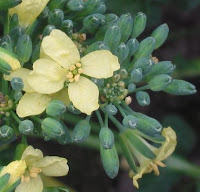 It's that time of year. When the heat and sunshine cast out those cold and rainy days making the conditions ripe for the emergence of those dormant and overwintering garden insects.
It's that time of year. When the heat and sunshine cast out those cold and rainy days making the conditions ripe for the emergence of those dormant and overwintering garden insects.The other day when I was puttering around in my garden I uncovered a whole array of different insects taking up residence. I have been studying insects and their management over the last 5 months so this was geek-out central for me and needless to say, a very exciting discovery. However, for many gardeners, the sign of pests in their garden is anything short of exciting.
My specimens included spittlebug, aphids, whitefly, silverfish, leafminer, spider mites, a beet armyworm (one of the many destructive caterpillars found in gardens) and all kinds of incubating eggs. This was the optimal time to do some de-bugging before the numbers of these guys increased, which in some cases can be as fast as 48 hours.
 |
| Whitefly |
The world of insects and the control of them is a vast subject that people devote their entire life to studying. So in the interest of keeping this brief and not boring you to tears, here are a few tips on how to keep those buggers in check.
Now is the time to become proactive in your gardens. Early detection is key in controlling pests. Once the population becomes large, it may be too late to control it, so check your plants regularly, 2-3 times a week if possible. Get up close and inspect all parts of your plants and its inhabitants - the stems, the leaves - especially the undersides - the soil, and underneath any pots, mulch or other crevices that earwigs, snails, slugs, or sowbugs can hide under.
REMOVAL
If in your monitoring you notice any pests, removing them is essential. Handpick and destroy insects like caterpillars, slugs, or snails. Wipe off any eggs found on the undersides of leaves. Spray aphids off with a strong jet of water.
PREVENTION
Keep your soil healthy by regularly tilling and amending. Select healthy, organic plants and untreated, certified organic seeds and plant them correctly. Use sticky traps to capture male insects and prevent mating. Use crop rotation to break the cycle of pests and disease. Encourage natural enemies and beneficial insects by increasing the diversity of crops in your garden, i.e., companion planting and intercropping. Water appropriately according to the needs of your plants. Remove and destroy severely diseased plants.
PESTICIDES
While I highly recommend all the above methods FIRST, there are some instances where pesticide use is necessary. Pesticides can be organic or inorganic. Insecticides, herbicides, fungicides and chemical substances are all agents that fall under the pesticide definition. If you use a pesticide, read and use it according to the label and be informed of the potential human and environmental affects. Although not devoid of it's potential hazards, I typically use OMRI www.omri.org approved products. They are considered certified "organic" (we could have a whole discussion about that alone) and are relatively non-toxic and safe for the environment. Some commonly used organic pesticides are horticultural oils, neem oil, insecticidal soaps, and BT (Bacillus thuringiensis). Refrain from the use of toxic pesticides as they cause long term harm for a short term result.
It is unlikely that you will ever get rid of all your garden pests nor would you want to since part of keeping a balanced ecosystem is maintaining the presence of beneficial insects which means providing them with a food source - your garden pests. We live in a world where our food can be purchased perfectly unblemished from the grocery store. But when you grow your own edibles, some damage is inevitable. The holes in your kale, the nibbles on your lettuce, bruises on your apples, or disfiguration of your tomatoes is ok and actually quite special because in the natural order of mother nature, everything is imperfectly balanced.
















